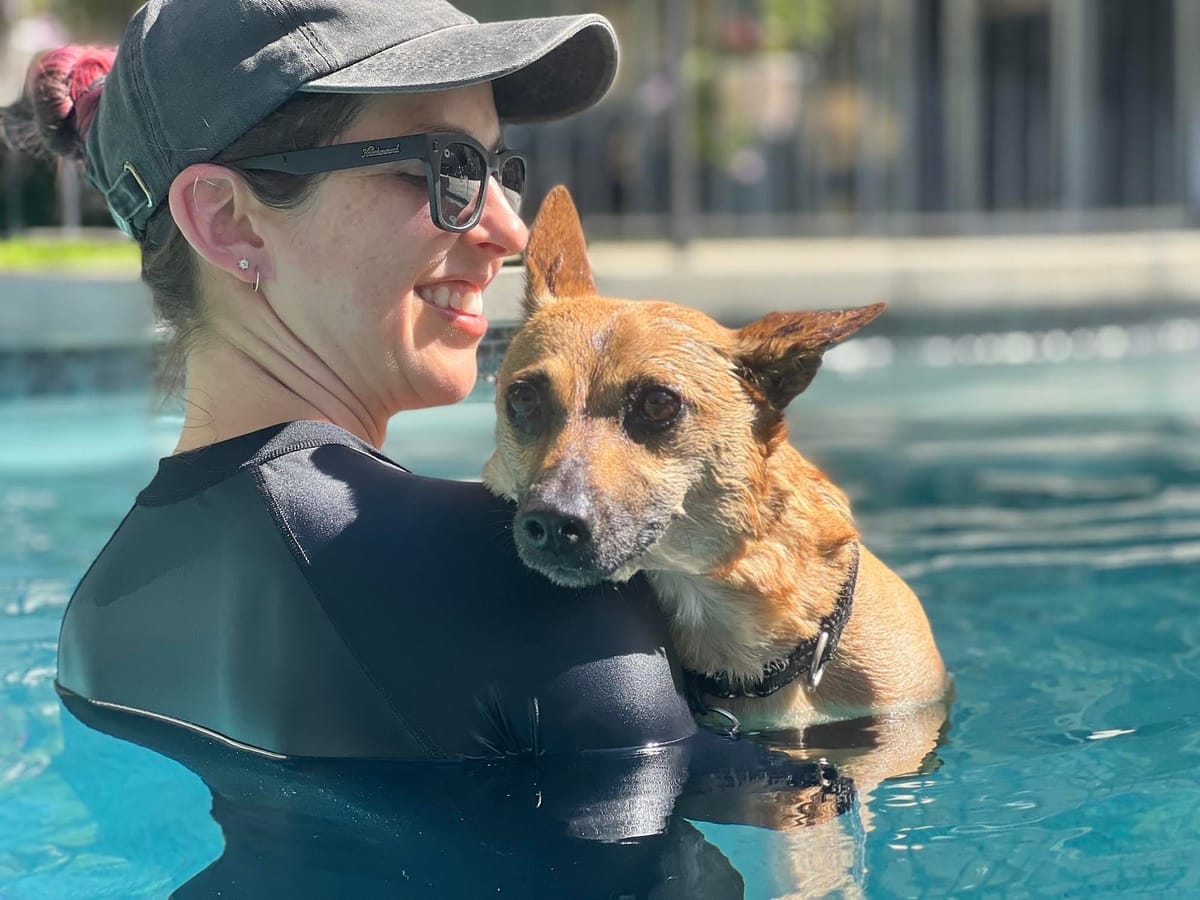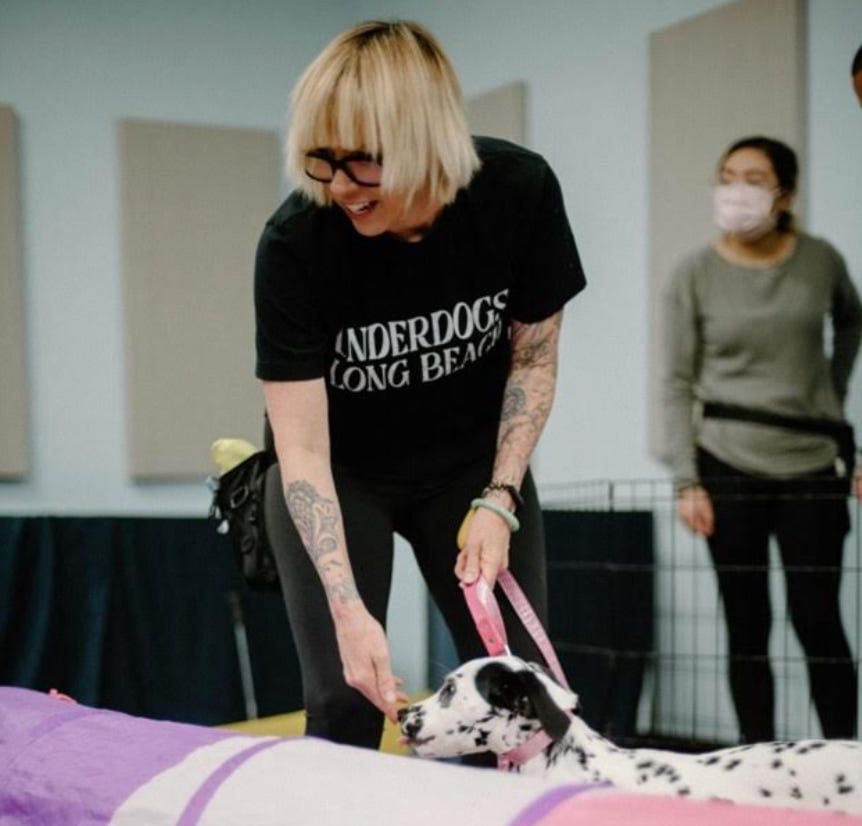Scratch This: Meet the Muttley life coaches who help humans with their barking bowsers
Explore behavioral tips for your dog, a list of adoptable pups and weekend events.

We live on a block of small multifamily dwellings. A dog who howls when a fire engine or a police car passes and sounds its siren lives in the building on our left. It’s heartbreaking. The single dog in our building is silent and minds her own beeswax. To our right is one unit with a dog and a cat, one with two dogs, and a third with no pets at all. The single dog makes not a sound, but the other two barked and howled incessantly when they moved in a few weeks ago. They’ve gotten used to their new home and have calmed down, but one still barks if he hears so much as a sneeze.
We’re fine with barking dogs — if someone’s snooping around, we get an alert, for which we’re thankful. But with excessive, non-triggered barking, we worry that the dogs are in some distress, especially if they’re howling, too. Yes, we have spoken to the neighbors, who were friendly and receptive. Not everyone is, though.
“I really wish that people would take their dog’s feelings into consideration,” said Long Beach resident Amrita Kelley. Kelley has a large dog, for whom she once drove all the way up to Camarillo to provide behavior training for his puppy issues.
So, how do you help a barking dog before the neighbors (not us) report them to the shelter?
Long Beach Watchdog is a reader-supported publication. To receive new posts and support my work, consider becoming a free or paid subscriber.
“Our animal care team does receive these questions often, and we always want to direct our community members to the resources section of our website referencing separation anxiety and dog barking,” said Christopher Hawkes, who does triple duty as Long Beach Animal Care Services’ behavior, enrichment and transfer coordinator. That section, by the way, is a goldmine of suggestions and has been added to the resources link at the end of the column.
Hawkes and his team also provide new adopters with information on how to mitigate initial barking and separation anxiety.
“We encourage adopters to give their new pet solid boundaries upon initial entrance into the home,” Hawkes said. “It’s always a good idea to make sure your new pet doesn’t become anxious or unsettled under the impression you’re not going to return when you leave the home, by starting an initial routine of crating or confining the dog into a specific area in the home while you manage chores. They will see you leave and return as you move about the home.”
Find a behaviorist
If your dog responds to these tips, good for both of you! But if the barking persists or if you need a supplement to them, professional training will be necessary. Laura Vena, founder of Blockhead Brigade, has great success with her pack walks, so I asked her if she knew any trainers to help with barking dogs.
"A behaviorist is best equipped to identify the cause of the behavior, the needs of the individual dog, and the limitations or capacity of the family," Vena said. "There are many great local ones, and each has a specialty.”
A certified behaviorist, she said, is best for figuring out why the dog is barking and the appropriate approach to improve their response. Vena herself is studying for her certification.
“While dog trainers typically focus on specific skills, behaviorists evaluate the underlying causes of problematic behaviors in dogs, which often stem from fear or anxiety,” Vena said. “Behaviorists use scientific principles and evidence-based knowledge to accurately identify and treat behaviors in dogs.”
A behaviorist will do an initial evaluation to diagnose causes of and factors involved in barking. Then, they create a plan tailored specifically to the dog and their family. Each animal, including the human variety, is an individual with a particular personality and their own reasons for their behavior.
“Something like barking, in my opinion, cannot be addressed with obedience,” Vena said. “As with everything in dog behavior, the solution is dependent upon the cause, circumstances and environment. Is it an expression of frustration from a lack of exercise or enrichment? Is the dog bored? There’s a fix for that, which includes ideas for satisfying a dog’s needs before they are left alone — quick games and engagement.
“Is the dog being triggered by noises and movement outside its door? Is there a way to keep the dog away from the front door or to play calming music to reduce any triggering that might be happening because of noise or activity outside? It’s also important to know if they have separation anxiety.”
Some trainers have experience with pet behavior

Lisa Darcy has worked for nearly 10 years as a trainer with the well-known LiveLove Animal Rescue and is currently working through the Training Without Conflict certification program; Jill Guin operates Underdogs Long Beach and is a certified separation anxiety specialist. She holds a degree in applied animal behavior from the University of Washington and is also certified at the Karen Pryor Academy for Animal Training and Behavior. Both of them had convergent and divergent ideas about behavior training (I live with cats, so I have no idea what works) Guin said that there are licensed cat trainers, but that’s another article and mine don’t bark, anyway. But both trainers are well informed, and each gave me enough information for a small handbook.
Darcy’s initial advice is to rule out any health issues — pain, for instance — that may cause barking before spending money on training. If the dog is healthy, start figuring out what’s triggering the barking.
“And the owner needs to be on board for putting in some work,” Darcy said.
Darcy said that she’d want to know the dog’s general personality, their daily schedule, how much exercise they’re getting, whether they’ve had previous training in other areas such as crate and obedience, and if they act the same way when their humans are home. (For this, they’d probably ask a neighbor.) Then, they’d want to identify triggers and possible reasons for barking.
“Dogs don’t speak our language — they communicate in subtle body language, then bark when a trigger is too intense,” Guin said. “When we think about triggers, we think of them as not good or bad but a trigger to something happening in the environment. Like your email triggering an alert.”
Barking, Guin said, can communicate excitement about seeing another dog, a human, a squirrel. It can communicate a need for space or warn us that someone is outside the home.
“Some may even love to bark and can do it all day long!” Guin said.
Boredom may also be a trigger. Boredom can result from lack of stimulation or through a genetic need not being met; for example, breeds or mixes thereof that had been bred to hunt or herd. Bored dogs, particularly “teenagers” between 6 months and 2 years old, will also destroy everything within toothshot and engage in other undesirable behaviors, Guin said. Other dogs bark from stress and triggers outside, especially in busy neighborhoods.
“They practice aggression toward the outside world and might even bite if they were to escape — ask any postal worker,” Guin said.
Separation anxiety is the most heartrending of all the triggers. The dog’s security humans are gone, there may be no other pet to keep them company, and the poor pooch has no idea if they’ll see their people again. They’ll bark and howl all day.
“These dogs are having panic attacks and need help,” Guin said.
Helping your dog get through their day
First, Guin said, acknowledge that barking is normal and acceptable behavior for a dog. Then, get an action plan and a behavioral-modification plan.
Darcy provided a grab bag of boredom defectors: Be sure that the dog has plenty of exercise before you leave, be it walking, play or both; leave them with safe playthings to keep them occupied, such as food puzzles or hollow Kong toys stuffed with goodies and prefrozen; if you’re gone all day and it’s in your budget, hire a midday dog walker.
Darcy and Guin suggested managing reactivity, howling and “alert barking” by limiting their access to windows or any area that triggers a reaction. Some trainers suggest crate training; others do not, but baby gates can work if they’re strong enough. So can window coverings and decals, closing windows if you have air conditioning and heat, and turning on the TV or getting a white-noise machine to lessen the effects of outside sounds. Guin uses a machine that produces white, pink and brown noise, which have different frequencies for different effects on the dog or human. I saw them listed cheaply enough on that site that has delivery trucks that block one-way streets.
“When the owners are home, they can teach a ‘quiet’ cue or use treats when the dog sees people or dogs passing to help create a more positive association,” Darcy said.
Both trainers said that separation anxiety is a tough call and won’t go away by itself. Guin said that a veterinarian, a behaviorist or both be consulted for help.
“They’re the only qualified professionals to diagnose separation anxiety,” Guin said.
Training isn’t punishment
The training and study that Guin is involved in is a scientific method called counter-conditioning and desensitization, which addresses the animal’s state of mind, if that’s accurate, and gradually gets their needs met.
First of all, Guin said, barking is what dogs do.
“You don’t want to extinguish barking when someone approaches the front door, even the mailman,” Guin said. “If they’re barking incessantly, that’s a sign that their needs aren’t being met. We need to change their internal focus, not punish it. Yelling at the dog, what does that do? Now we’re both yelling, and I’m intensifying the situation, making it more tense!”
Guin disapproves of training dogs through dominance, punishment, intimidation and aggressive methods like applying facial pressure to get the dog to lie down. Darcy doesn’t like the idea of slapping a bark collar on a dog without working with a trainer — bark collars deliver negative reinforcement in the form of vibration, a shock or a spray of citronella.
Neither trainer thinks that any barking dog is a hopeless case. With willingness to be there for the long haul coupled with patience, training and understanding that a dog is a dog, a person who lives with a pooch can eventually not worry about the neighbors filing a complaint. Even better, you’ll have a happy, well-adjusted BFF.
“Dogs bark because it’s their genetic need and they love it,” Guin said. “We can help them by meeting those needs.”
Yours drooly
Safe Rescue Team joined the pantheon of dedicated rescuers and rescues in 2019. The rescue’s goal is to save every dog they can — abused dogs, abandoned dogs, neglected dogs, and dogs in danger of shelter euthanasia. If they have room, they will take in dogs relinquished by their owners.
“Our ultimate goal is to create a world where all companion animals have loving and permanent homes—where no good-natured dogs, no matter what their age, are killed in shelters because they are considered to be surplus or unadoptable,” said founder Markelle Pineda on the rescue’s website.
Here are three of the lucky doglings all ready to go home with you. Each dog — all of them under Safe Rescue Team’s care have been vaccinated, spayed or neutered, microchipped, provided with full health examinations, dewormed and flea treated. Each comes with their rabies certificates, health papers and vet records. Adoption applications are available here.
Remember, you and the dog are forever friends, and forever means forever.

This sweet boy is handsome Prince. He was hit by a car and surrendered to the shelter with a broken leg. Safe Rescue Team sprung him, got his leg surgically corrected, and promised to find him the happily-ever-after that every real Prince deserves! Prince is about 2 years old, weighs 35 pounds, and is a fun, playful, loving fellow. He loves dogs, kids and cats. Best of all, he’s potty trained. He would do great in any environment. He is such a sweet and kind gentleman! Prince is not a huge fan of crates but he doesn’t need one — he doesn’t get up on furniture and he’s never And has the cutest mohawk ever!

Scout and her sweet sister Izzy were victims of backyard breeding (grrrrr), and were the only two left of the litter when the landlord found out. Thankfully, Safe Rescue Team was there to catch them in their safety net. The two weren’t even vaccinated and were scared to death! Izzy’s gone home, but Scout’s still waiting. She’s a super-tiny Chiweenie — sweet, adorable, shy, dog-friendly, and potty trained. She’s still a scaredy-cat, but the team is working with her to show her that not everyone is mean and scary. She is doing amazing — love heals! Scout would do best in with another family dog, in an adult household. She is kid-friendly — she’ll just take time to warm up.

This little lady is about a year old and is 19 pounds of pure love and crazy doodle energy! Her name’s Coconut and she gets on great with other dogs. She’d do best with someone who understands the needs of a high-energy working-breed dog and has the time and patience to follow through with schedules and boundaries and to exercise the wiggles out of her!
Tail-wagging and nose-booping things to do
Low-cost vaccination clinic at Long Beach Animal Care Services
The cost of medical care for pets can be a deterrent for people struggling to pay household bills. Because pets are family members, Long Beach Animal Care Services and CAMP (Community Animal Medicine Project) are knocking down the price barriers. CAMP’s mobile clinic will drive into the LBACS lot on May 24 to offer low-cost vaccines — shots, prices and information about other clinics available here. Bring past vaccine records, and keep your dog leashed and your cat in a carrier. No appointment necessary, but get there early because the clinic is open to the first 60 patients.
The low-cost clinic takes place Friday, May 24, 10 a.m.–3 p.m. at Long Beach Animal Care Services lot, 7700 E. Spring St., Long Beach, at entrance to El Dorado Park. No parking fee for shelter guests.
District 7 Adoption Series
Join Long Beach Animal Care Services and the office of Councilmember Roberto Uranga at the shelter’s next episode of their adoption series. LBACS will waive adoption fees and provide information about spay/neuter vouchers, pet licensing and pet laws.
The adoption event takes place May 25, 10 a.m.–noon, in Veterans Park, 101 E. 28th St., Long Beach
Floyd’s Pack Walk
You and your well-behaved, social dog are invited to enjoy a day in the sun (hopefully) and a 1.5 mile trek with other like-minded canines and humans. The pack walks are a regular thing, held in honor of the organizer’s dog whom she successfully trained. Notes: all dogs must be leashed (6-foot nonretractable leashes recommended), maintain an 8-foot distance between you and other dogs, reward good behavior, and keep attending pack walks because consistency is key in behavior training. If you feel you need to exit the walk, move to one side or cross the street. Wear bright-yellow shirts and yellow scarves for the doggies. Access this link to purchase shirts and scarves and for more information.
Floyd’s Pack Walk takes place May 25, 10 a.m.–11 a.m., in front of Long Beach Utilities at Wardlow Park, 3457 Stanbridge Ave., Long Beach
Enter your pet in the Face of Fog City photo contest
Your pet can be the face of Pet Food Express’ new brand, Fog City Pet! Fog City was named for Pet Food Express’ Bay Area origin and is an exclusive brand based on sustainability and reducing waste. Fog City Pet features durable pet bowls, beds with 100% recyclable filling, plant-based shampoos, and limited-ingredient treats for dogs and cats. To enter your pet, boot up your Instagram or set up an account, follow Pet Food Express, upload a photo of your pet and tell why they should be the face of Fog City Pet. Tag @PetFoodExpress and use #FaceofFogCityPet in the caption, and Bingo was his name! Your best buddy has a chance of being crowned the Face of Fog City Pet!
Entries accepted through May 26. The grand prize winner gets a professional photoshoot of their pet, a year’s supply of Fog City Pet goodies, and a $500 Pet Food Express gift card. The new Face will be featured in Fog City Pet’s marketing on social media, their website, and digital advertising. Five second-place winners receive a $250 Pet Food Express gift card. Photo entries will be reviewed and voted on by a panel of Pet Food Express employees. Winners will be chosen June 3 and notified through Instagram direct message. Further information here.
Editor’s note: The section ‘Find a behaviorist’ has been clarified to better explain the work that they do.
Need a low-cost veterinarian, information about trapping community cats, places to volunteer — anything pet-related? Follow this link for resources. Please add your own ideas in the Comments section.Kate Karp has covered animal care and pets in Long Beach for almost two decades. Her new column, Scratch This, will be published in the Long Beach Watchdog every week.
We need your support.
Subcribe to the Watchdog today.
The Long Beach Watchdog is owned by journalists, and paid for by readers like you. If independent, local reporting like the story you just read is important to you, support our work by becoming a subscriber.





